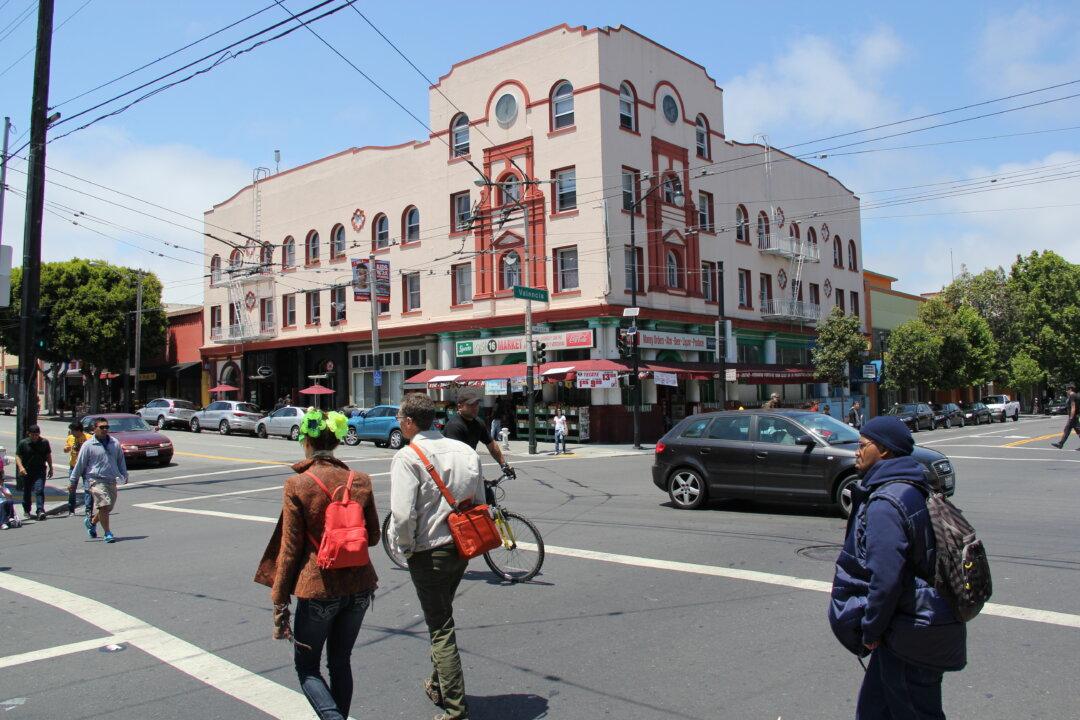SAN FRANCISCO—Being touted as one of the most walkable cities in the country, San Francisco is also one of the most dangerous for pedestrians.
The city holds the dubious distinction of being California’s deadliest city for walking, with 19 pedestrians killed last year. In 2012, 964 people were hit by cars—almost three pedestrians per day, according to Walk SF, a pedestrian advocacy group, citing police department data.
Politicians and city planners are not short of good ideas and lofty goals for safer streets. The recently released San Francisco Pedestrian Strategy aims to reduce pedestrian injuries 50 percent by 2021. Besides stricter policing, better street design is expected to do the trick.
New legislation seeks to streamline the process of creating street-safety upgrades by encouraging agencies to cooperate and by changing outdated codes.
It is common sense that reducing the number of lanes, narrowing intersections with bulb-outs, and upgrading curb ramps can effectively slow traffic, increase visibility, and thus can get pedestrians across the street more safely. Especially for slower folks such as children and the elderly, such safety upgrades can make life-deciding difference.
However, often in the past obstacles have prevented several such projects from coming to fruition.
Many projects suffer when they go through the “black box” of technical review, said Elizabeth Stamp, executive director of Walk SF, at the Land Use and Economic Development Committee meeting Monday.
“Then at the end,” she said, “a plan comes out that has suffered a death by a thousand cuts, and it’s not a good plan anymore, and the public doesn’t have any recourse on the decisions.”
It’s mainly a lack of coordination and communication among the handful of city agencies involved in street improvements that can bring them to a halt, Supervisor Scott Wiener said at the meeting.
Together with Supervisor Norman Yee, Wiener has introduced several pieces of legislation aiming to remedy the problem.
“We absolutely need to make it easier to make changes to our physical environment,” he said.
For example, the Public Utilities Commission might object to a street narrowing because it would affect a water pipe going through. Under current laws, the agencies share responsibility for the engineering projects, and one objection is enough to stop it.
“There are few things that are more demoralizing for a neighborhood than to go through a great planning process only to have a project shut down,” said Wiener.
One ordinance would create a Street Design Review Committee. Manned by department heads and chaired by Mayor Ed Lee, the committee is meant to help city agencies to see the bigger picture and better collaborate with each other.
Instead of ending a project, departments would be encouraged to work around issues when policy conflict or other problems come up.
Another piece of legislation in the package would urge the departments to update any outdated codes and guidelines and create a clear policy on reviewing projects where agency responsibilities overlap in order to speed up the process.
Also discussed Monday was legislation that would change the city’s fire code to allow for the narrowing of lanes, which is often at odds with the current requirements for fire truck access. Many cities such as Oregon and Seattle have demonstrated that a smaller clear width of 11 feet is sufficient, while San Francisco’s current fire code provision requires 20 feet, said Patrick Siegman, principal at transportation planning firm Nelson\Nygaard on Monday.
“We have a lot of great plans,” Wiener said. “This legislation will bring our process and our standards in line with our words.”




